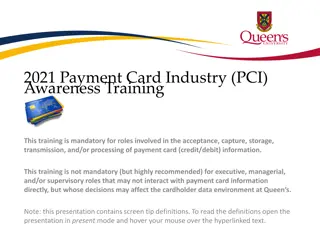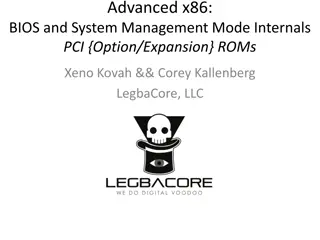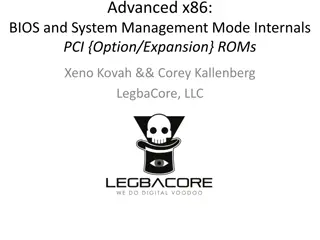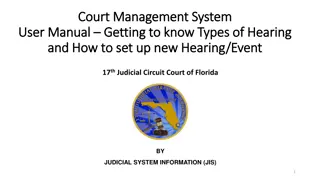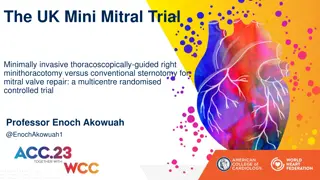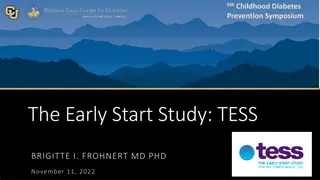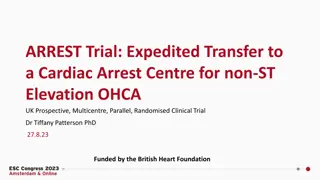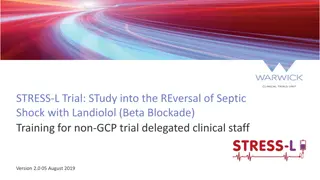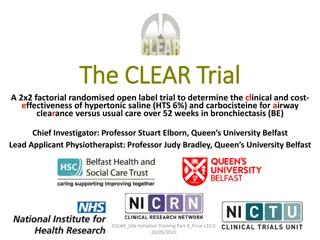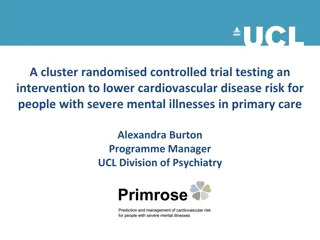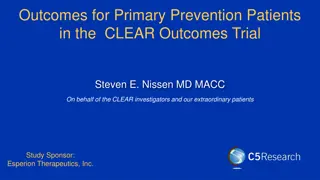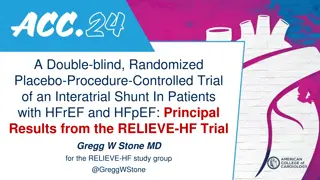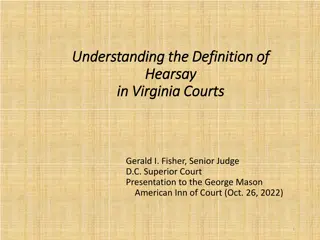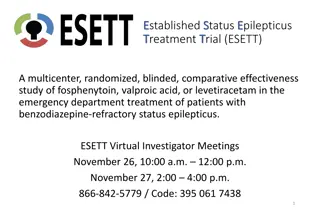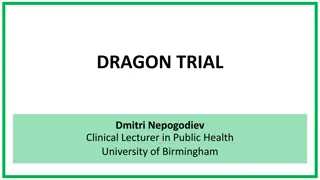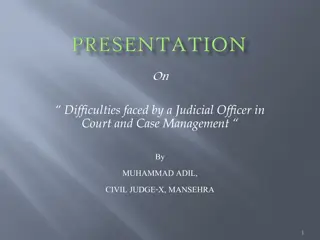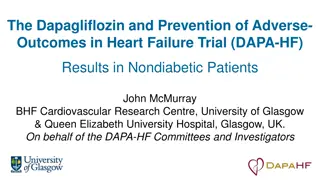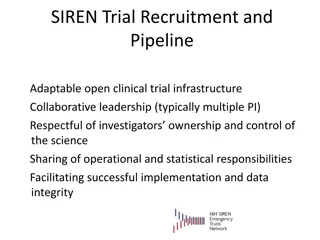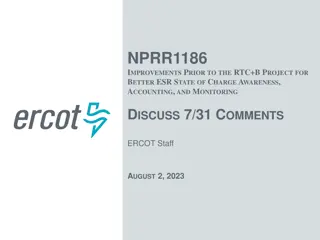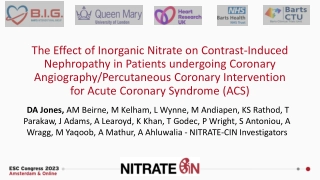Comparison of FFR-guided PCI vs Angiography-guided PCI in AMI with Multivessel Disease: FRAME-AMI Trial
In patients with acute myocardial infarction (AMI) and multivessel coronary artery disease, this study aims to compare fractional flow reserve (FFR)-guided PCI with angiography-guided PCI for non-infarct-related artery lesions. The hypothesis is that selective PCI guided by FFR is superior to routine PCI guided only by angiography in treating non-IRA lesions in AMI. The FRAME-AMI Trial is an investigator-initiated, randomized trial in Korea involving 14 sites. Key inclusion criteria include patients aged 19 years or older with STEMI or NSTEMI undergoing successful primary or urgent PCI of an IRA, with at least one non-IRA lesion eligible for PCI. Primary endpoints include a composite of death, MI, or repeat revascularization, with key secondary endpoints focusing on individual components of the primary endpoint.
Download Presentation

Please find below an Image/Link to download the presentation.
The content on the website is provided AS IS for your information and personal use only. It may not be sold, licensed, or shared on other websites without obtaining consent from the author. Download presentation by click this link. If you encounter any issues during the download, it is possible that the publisher has removed the file from their server.
E N D
Presentation Transcript
FFR vs. Angiography-guided PCI in AMI with multivessel disease FRAME-AMI trial Joo-Yong Hahn Samsung Medical Center, Seoul, Korea 28 August
Background In patients with acute myocardial infarction (AMI) and multivessel coronary artery disease, percutaneous coronary intervention (PCI) of non-infarct related artery (IRA) lesions for complete revascularization improves clinical outcomes. However, optimal strategy to select targets for non-IRA PCI has not been clarified.
Objective To compare fractional flow reserve (FFR)-guided PCI with angiography-guided PCI for non-IRA lesions among patients with AMI and multivessel disease Hypothesis Selective PCI guided by FFR is superior to routine PCI guided by angiography alone for treatment of non-IRA lesions in patients with AMI and multivessel disease.
Study design FRAME-AMI Trial (NCT02715518) An investigator-initiated, randomized trial at 14 sites in Korea
Study Organization PI Joo-Yong Hahn Executive Committee Joo-Yong Hahn, Joo Myung Lee, Young Bin Song, Changwook Nam, Joonhyung Doh DSMB Jun-Hee Lee (Chair), Seon Woo Kim, Sang-Ho Cho CEAC Jin-Man Cho (Chair), Sung-Woo Cho, Eun-Kyung Kim Centers 14 centers in Korea Medtronic, BIOTRONIK, Chong Kun Dang Pharmaceutical, and JW Pharmaceutical Sponsors
Enrollment criteria Key inclusion criteria Patients ( 19 years of age) with STEMI or NSTEMI undergoing successful primary or urgent PCI of an IRA At least one non-IRA lesion with diameter stenosis >50% in major epicardial coronary artery or major side branch with vessel diameter of 2.0 mm by visual estimation to be amenable to PCI Key exclusion criteria Single-vessel disease Target lesion located in the left main coronary artery Cardiogenic shock Chronic total occlusion in non-IRA
Study end points Primary end point A composite of death, MI, or repeat revascularization Key secondary end points The individual components of the primary end point Cardiac death Procedure-related MI Spontaneous MI Revascularization for non-IRA Definite stent thrombosis
Sample size calculation Expected annual event rate of the primary end point 3.5% with the FFR-guided strategy and 6.0% with the angiography- guided strategy Accrual time: 3 years Additional follow-up time after the end of recruitment 1 year Sampling ratio of 1:1 Drop-out rate: 1% A total of 1292 patients (646 per group) would provide 90% power at a 2-sided type I error of 5%.
Early termination of the study During the study period, the Covid-19 pandemic occurred, and enrollment became substantially slow. The incidence of hospitalization for AMI decreased globally by as much as 50 percent during the pandemic. Several centers halted the trial due to temporary unavailability of facility, lack of personnel, and concerns about the spread of Covid-19. December 2020, the executive committee made the decision to terminate the trial early because of difficulty in recruitment and the DSMB agreed to this closing. Scheduled follow-up of enrolled patients was continued.
Baseline characteristics (I) FFR-guided PCI Angiography-guided PCI (N=284) (N=278) 63.9 11.4 62.7 11.5 Age, years 240 (84.5%) 234 (84.2%) Male, n (%) 24.7 3.1 24.9 3.4 Body mass index, kg/m2 151 (53.2%) 152 (54.7%) Hypertension 97 (34.2%) 86 (30.9%) Diabetes mellitus 121 (42.6%) 107 (38.5%) Dyslipidemia 91 (32.0%) 105 (37.8%) Current smoking 8 (2.8%) 8 (2.9%) Chronic renal disease 9 (3.2%) 15 (5.4%) Previous stroke 7 (2.5%) 7 (2.5%) Previous MI 17 (6.0%) 20 (7.2%) Previous PCI
Baseline characteristics (II) FFR-guided PCI Angiography-guided PCI (N=284) (N=278) 53.2 9.8 53.6 10.2 LV ejection fraction, % Initial presentation, no. (%) 131/284 (46.1%) 134/278 (48.2%) ST-segment elevation MI 153/284 (53.9%) 144/278 (51.8%) Non-ST-segment elevation MI Discharge medication, no. (%) 279 (98.2%) 277 (99.6%) Aspirin 280 (98.6%) 276 (99.3%) P2Y12 inhibitor 85 (29.9%) 74 (26.6%) Clopidogrel 122 (43.0%) 133 (47.8%) Ticagrelor 73 (25.7%) 69 (24.8%) Prasugrel 273 (96.1%) 272 (97.8%) Statin 210 (73.9%) 221 (79.5%) Beta blocker 191 (67.3%) 194 (69.8%) ACE inhibitor or ARB
Lesion and procedural characteristics: IRA FFR-guided PCI Angiography-guided PCI (N=284) (N=278) Location of infarct related artery, no. (%) 90 (31.7%) 105 (37.8%) Left anterior descending artery 69 (24.3%) 61 (21.9%) Left circumflex artery 125 (44.0%) 112 (40.3%) Right coronary artery 242 (85.2%) 229 (82.4%) Radial access, no. (%) 52 (18.3%) 45 (16.2%) Thrombus aspiration, no. (%) 61 (21.5%) 45 (16.2%) GPIIbIIIa inhibitor use, no. (%) 277 (97.5%) 276 (99.6%) Use of drug-eluting stent, no. (%) 63 (22.5%) 59 (21.2%) Intravascular imaging used, no. (%) 3.1 0.5 3.2 0.5 Mean stent diameter (mm) 36.3 18.2 34.7 15.4 Total stent length (mm) 284 (100.0%) 277 (99.6%) Procedural success, no. (%)
Lesion and procedural characteristics: non-IRA (I) Per patient FFR-guided PCI Angiography-guided PCI P Value (N=284) (N=278) 0.770 Timing of non-infarct related artery PCI, no. (%) 172 (60.6%) 165 (59.4%) Immediate PCI during same procedure 112 (39.4%) 113 (40.6%) Staged intervention during same hospitalization 1.4 0.6 1.3 0.6 0.068 Number of non-IRA lesions 182 (64.1%) 270 (97.1%) <0.001 At least 1 non-IRA lesion treated, no. (%) 177/182 (97.3%) 256/270 (94.8%) 0.385 Use of drug-eluting stent 57/182 (31.3%) 77/270 (28.5%) 0.593 Intravascular imaging used, no. (%) 0.9 0.9 1.3 0.7 <0.001 Mean no. of stents used for non-IRA 182/182 (100.0%) 270/270 (100.0%) NA Procedural success, no. (%)
Lesion and procedural characteristics: non-IRA (II) Per lesion FFR-guided PCI Angiography-guided PCI (N=388 lesions) (N=366 lesions) Location of non-IRA lesions, no. (%) 189/386 (49.0%) 143/366 (39.1%) Left anterior descending artery 105/386 (27.2%) 113/366 (30.9%) Left circumflex artery 92/386 (23.8%) 110/366 (30.1%) Right coronary artery QCA in non-IRA 3.1 0.5 0.9 0.4 71.5 13.1 22.3 12.5 3.1 0.5 0.7 0.4 75.4 11.5 21.1 10.4 Reference vessel diameter, mm Minimum lumen diameter, mm Diameter stenosis, % Lesion length, mm FFR data 0.79 0.11 - FFR 0.88 0.06 - Post-PCI FFR Non-IRA PCI 226/386 (58.5%) 345/366 (94.3%)
Primary end point A composite of death, MI, or repeat revascularization 19.7% 7.4%
Clinical outcomes FFR-guided PCI Angiography-guided PCI Hazard Ratio End Point P Value (N=284) (N=278) (95% CI) Death, myocardial infarction, and repeat revascularization 18 (7.4%) 40 (19.7%) 0.43 (0.25-0.75) 0.003 All-cause Death 5 (2.1%) 16 (8.5%) 0.30 (0.11-0.83) 0.020 Cardiac death 3 (1.4%) 15 (8.2%) 0.19 (0.06-0.67) 0.010 Myocardial infarction 7 (2.5%) 21 (8.9%) 0.32 (0.13-0.75) 0.009 Procedure-related myocardial infarction 3 (1.1%) 11 (4.0%) 0.26 (0.07-0.94) 0.041 Spontaneous myocardial infarction 4 (1.4%) 10 (5.0%) 0.39 (0.12-1.23) 0.108 Repeat revascularization 10 (4.3%) 16 (9.0%) 0.61 (0.28-1.34) 0.216 Infarct-related artery 4 (2.2%) 8 (5.0%) 0.49 (0.15-1.61) 0.237 Non-infarct related artery 7 (2.6%) 12 (5.7%) 0.56 (0.22-1.43) 0.230 Definite stent thrombosis 0 (0.0%) 1 (0.4%) NA NA Cerebrovascular accident 4 (1.4%) 3 (1.1%) 1.30 (0.29-5.81) 0.730 Contrast induced nephropathy 2 (0.7%) 1 (0.4%) 1.97 (0.18-21.67) 0.581
Clinical outcomes FFR-guided PCI Angiography-guided PCI Hazard Ratio End Point P Value (N=284) (N=278) (95% CI) Death, myocardial infarction, and repeat revascularization 18 (7.4%) 40 (19.7%) 0.43 (0.25-0.75) 0.003 All-cause Death 5 (2.1%) 16 (8.5%) 0.30 (0.11-0.83) 0.020 Cardiac death 3 (1.4%) 15 (8.2%) 0.19 (0.06-0.67) 0.010 Myocardial infarction 7 (2.5%) 21 (8.9%) 0.32 (0.13-0.75) 0.009 Procedure-related myocardial infarction 3 (1.1%) 11 (4.0%) 0.26 (0.07-0.94) 0.041 Spontaneous myocardial infarction 4 (1.4%) 10 (5.0%) 0.39 (0.12-1.23) 0.108 Repeat revascularization 10 (4.3%) 16 (9.0%) 0.61 (0.28-1.34) 0.216 Infarct-related artery 4 (2.2%) 8 (5.0%) 0.49 (0.15-1.61) 0.237 Non-infarct related artery 7 (2.6%) 12 (5.7%) 0.56 (0.22-1.43) 0.230 Definite stent thrombosis 0 (0.0%) 1 (0.4%) NA NA Cerebrovascular accident 4 (1.4%) 3 (1.1%) 1.30 (0.29-5.81) 0.730 Contrast induced nephropathy 2 (0.7%) 1 (0.4%) 1.97 (0.18-21.67) 0.581
Cardiac death, spontaneous MI, or Repeat Revascularization 15.8% 5.7%
Study limitations Early termination Given the observed event rates, median follow-up duration, and number of enrolled patients, the actual power of our trial to show the difference in the primary end point between the 2 groups would be 95.3%. Both STEMI and NSTEMI patients with multivessel disease were evaluated in the present study. Randomization was stratified according to the type of MI, and there was no significant interaction between treatment effect of FFR- guided PCI and type of MI for the primary end point between the 2 groups.
Conclusions Among patients with AMI and multivessel disease, a strategy of selective PCI using FFR-guided decision making was superior to a strategy of routine PCI based on angiographic diameter stenosis for treatment of non- IRA lesions regarding a composite of death, MI, or repeat revascularization.
Acknowledgement I would like to thank patients enrolled, research nurses, study coordinators, and participating investigators. FRAME-AMI investigators Joo-Yong Hahn, Joo Myung Lee, Hyeon-Cheol Gwon, Seung-Hyuk Choi, Young Bin Song, Jeong Hoon Yang, Taek-Kyu Park, Ki-Hong Choi , Hyun Sung Joh , David Hong (Samsung Medical Center, Sungkyunkwan University School of Medicine, Seoul), Hyun Kuk Kim, Keun Ho Park (Chosun University Hospital, Gwangju), Eun Ho Choo, Chan Joon Kim (Uijeongbu St. Mary s Hospital, Uijeongbu), Min Chul Kim, Seung Hun Lee, Young Joon Hong (Chonnam National University Hospital, Gwangju), Sung Gyun Ahn (Wonju Severance Christian Hospital, Wonju), Joonhyung Doh (Inje university Ilsan Paik hospital, Goyang), Sang Yeob Lee (Chungbuk National University Hospital, Cheongju), Sang Don Park (Inha University Hospital, Incheon), Hyun Jong Lee, Ki Hyun Jeon (Sejong General Hospital, Bucheon), Jin-Sin Koh, Min Kyu Kang (Gyeongsang National University Hospital, Jinju), Chang-Wook Nam, Yun-Kyeong Cho (Keimyung University Dongsan Medical Center, Daegu), Bon-Kwon Koo (Seoul National University Hospital), Bong-Ki Lee (Kangwon National University Hospital, Chuncheon), Kyung Ho Yoon (Wonkwang University Hospital, Iksan) All in Korea.



